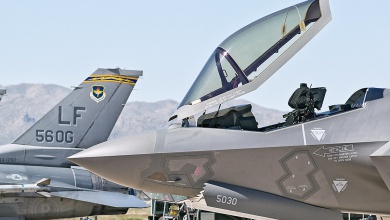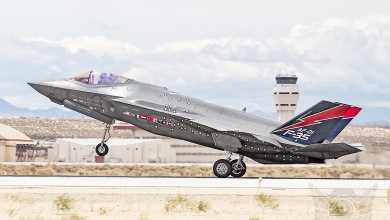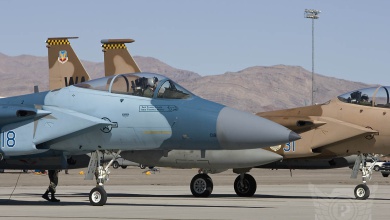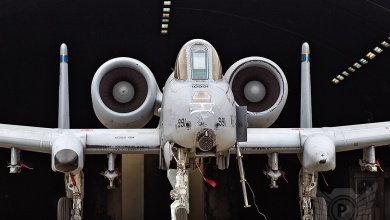Luke Air Force Base near Phoenix, Arizona has been the primary fighter training facility in the United States since 1941 and is currently home to the 56th Fighter Wing under Air Education and Training Command. Rooted into this active-duty community is a select number of Air Force Reserve men and women. They belong to the 69th Fighter Squadron and this is their story.
“My first impression: a lot of responsibility!” says Lt. Col. Korey Amundson in responds to his experience so far being the new squadron commander. The former Assistant Director of Operations was welcomed as the new 69th FS leader on May 2, 2014. With Luke AFB being selected as the Air Force’s primary F-35 training location, a lot of changes were set into motion and it is his responsibility to ensure employment for everybody in the squadron. The 69th FS currently has 50 instructor pilots and 5 staff members , of which 95 percent are senior officers. Amundson realizes that he might be the Chief but not here to lead a group of Indians. “It’s a Chief trying to lead a bunch of other Chiefs” as he puts it.



69th Fighter Squadron commander Lt. Col. Korey Amundson
Reserves at Luke Air Force Base
Back in 1987, when Luke Air Force Base (AFB) was still home to 58th Fighter Wing with Air Training Command, the Air Force Reserve (AFRES) activated the 944th Tactical Fighter Group with the subordinate 302nd Tactical Fighter Squadron (TFS) here. Established as a General Dynamics F-16 Fighting Falcon flying training squadron, the 302nd TFS operated its own fleet of F-16s with a distinct ‘LR’ (Luke Reserve) tailcode instead of the ‘LF’ tailcode carried by the active-duty squadrons at Luke. After being re-designated 944th Fighter Wing (FW), the wing expanded and in March 2000 the 301st Fighter Squadron was added as a sister squadron to the renamed 302nd Fighter Squadron under the newly formed 944th Operations Group (OG). However the 301st FS did not have their own aircraft, but acted rather as a so-called ‘classic associate’ unit to the 56th Fighter Wing. The unit was specifically created to retain experienced F-16 instructor pilots at Luke AFB and integrate them with the active-duty squadrons from the 56th OG. Interesting fact is that both of these reserve squadrons have historical ties to the iconic Tuskegee Airmen being part of the 332nd Fighter Group during World War II. Lt. Col. Amundson became a reservist in 2005 and joined the 302nd FS after serving as an instructor pilot (IP) with the 56th FW at Luke AFB for three years.
As a result of the 2005 Base Realignment and Closure (BRAC) recommendations, the 944th FW had to transfer all of their aircraft back to the active-duty Air Force with their last three F-16s leaving on February 17, 2007. With that the 302nd FS was no longer needed at Luke AFB, but its legacy was preserved with the squadron’s move to Elmendorf AFB, Alaska under the 477th Fighter Group to become an classic associate reserve F-22 squadron to the 3rd Wing. Like several other IPs, Commander Amundson assimilated into the 301st FS instead. However, his former full-time job turned into a part-time job, so he had to find employment elsewhere. He now is a part-time pilot for Delta Airlines flying Boeing 737s.

One year later, the 301st FS was also chosen to fly the F-22 at Holloman AFB, New Mexico because of its Tuskegee heritage. While remaining fully operational in support of F-16 training at Luke AFB, the squadron erected Detachment 1 at Holloman AFB to gradually stand up a classic associate reserve squadron to the local 49th FW. Once the 301st FS was ready to move to its new home, a replacement squadron was needed to fill up the void at Luke AFB. In a ceremony on March 5, 2010 the 69th FS took over its mission and all personnel. While pilots, Amundson included, symbolically changed their 301st FS patches to ones from the 69th FS, their brand new squadron commander Lt. Col. Steve Speckhard spoke: “It is with great pride and honor that we are able to bring the 69th Fighter Squadron back to Luke AFB”. He referred back to the time that the squadron previously operated from Luke AFB as the 69th Tactical Flying Training Squadron from October 1969 to March 1983.



Combat heritage
Like the 69th FS, common denominator for most of today’s U.S. Air Force (USAF) squadrons is that they all originate from the World War II era. The unit started out as the 69th Pursuit Squadron with the former U.S. Army Air Force which was activated under the 58th Fighter Group at Selfridge Field, Michigan on January 15, 1941. In the next two years, the squadron relocated to various other bases in successively the states of Louisiana, Florida, Virginia, Pennsylvania, Connecticut and eventually ended up in Bedford Army Air Base in Bedford, Massachusetts. Here the redesignated ’69th Fighter Squadron’ transitioned to the Republic P-47 Thunderbolt aircraft and prepared with the 58th FG’s two other squadrons for overseas operations beginning October 22, 1943.
The 69th FS arrived at Eagle Farms, Brisbane, Australia one month later and little did they know this would be the start of a two-year combat journey in the Southwest Pacific. From Australia they moved into New Guinea, followed by Noemfor Island, Dutch East Indies in September 1944. Two months later their tour of duty continued to Leyte and Luzon islands of the Philippines. While Japan was about to surrender, the squadron arrived on the Japanese Okinawa island on July 27, 1945. Once World War II came to an end, the 69th FS flew their aircraft back to the Philippines in December 1945 and officially disbanded January 27, 1946.
Back in action during the Korean War, the unit reactivated as the 69th Fighter Bomber Squadron at Taegu (now spelled Daegu) in Korea on July 10, 1952 followed by the move to Osan-Ni Air Base near Pyeongtaek on March 15, 1955. At first the squadron operated the Republic F-84 Thunderjet until 1954 when the pilots of the 69th transitioned to the North American F-86 Sabre which they flew until the squadron disbanded again on July 1, 1958.
A little over a decade later, the unit erected again as the 69th Tactical Fighter Training Squadron under the 58th Tactical Fighter Training Wing at Luke AFB. From October 1969 the squadron was tasked with training German pilots to fly the Lockheed F-104 Starfighter until March 16, 1983 when the 69th was deactivated for the third time.



Nevertheless just within months the unit, now redesignated 69th Tactical Fighter Squadron (TFS), stood up again at Moody AFB, Georgia in July of that same year. Taking over the tasking of the 339th TFS attached to the 347th Tactical Fighter Wing (TFW), the 69th TFS started flying with the McDonnell Douglas F-4E Phantom II, followed by several F-16 variants thereafter. They are called upon for Operation Desert Shield, followed by Operation Desert Storm with over 1.500 combat sorties flown. The now redesignated 69th FS again continued to deploy to the Southwest Asia region regularly to patrol the Iraqi no fly zone under Operation Southern Watch. At home the 69th was tasked with training F-16 pilots in which the instructor pilots could perfectly make use of their extended combat experience. By 2000 it was decided to transform the then called 347th Wing into a Rescue Wing, which left the subordinate 69th FS facing deactivation once more and the squadron officially disbanded February 2, 2001.
We are wolves
From the beginning, the squadron was known as ‘The Fighting 69’ and its official insignia pictured an iron fist holding a torch with clouds and a lightning bold in the background. It was at Bedford Army Air Base, just prior to their overseas deployment in 1943, where the pilots came up with the slogan ‘We Are Wolves’ which was spelled as ‘We’re Wolves’. This eventually evolved into their nickname still used today: Werewolves! A member of the squadron, who used to work for Disney, drew up a distinct werewolf character. This unofficial design was instantly worn on everyone’s jacket and applied to their aircraft, which led to an official approval soon thereafter.
However, between 1983 and 1990 the 69th FS carried a different nickname while stationed at Moody AFB. While the squadron took over the tasking, equipment and personnel of the 339th TFS, it somehow also inherited the 339th’s nickname ‘Dragons’ in the process. The patch design pictured a dragon holding a torch and lightning bold in the clouds; all distinct details linking back to the squadron’s original first insignia. Later the so-called Werewolf Alumni Association pressured on reinstating the werewolf insignia again, which resulted in the official return of the werewolf patch by September 1990 just prior to the squadron’s deployment to Southwest Asia in support of Operation Desert Shield. “Legend has it that a member of the 69th TFS was against the idea of adopting the werewolf over the dragon until one night at a country bar a woman told him that his dragon patch had a wimpy looking dragon. Soon after that the squadron did all the paperwork and received Air Force approval to make the werewolf the patch again” according to 69th FS historian Tech. Sgt. Adam Raley.


Plug-and-play
Given that the 69th FS is what is called a ‘classic associate’ reserve unit linked to the 56th Operation Group (OG), it integrates with all active-duty F-16 Formal Training Units (FTUs) based at Luke AFB. Currently a total of 50 reserve instructor pilots are assigned and all work in designated squadrons to provide the best support in training active-duty student fighter pilots. There is a set number of IP slots available with 23 full-time and 27 part-time jobs. Everyone is assigned to a specific squadron; either to one of the USAF squadrons (62nd FS, 308th FS or 310th FS) or to a Foreign Military Sales (FMS) squadron (21st FS – Taiwan or 425th FS – Singapore). The full-timers actually hold positions in the active-duty squadrons with some acting as Director of Operations or perform comparable functions for that particular FTU. The way it works with part-timers is that the 69th FS staff will forward their availability to the corresponding squadron scheduling offices which can coordinate all sorties needed for their training syllabus.
With an average of 2300+ flight hours flown in fighter aircraft and some having over 4000 flight hours, this pack of Werewolves is undoubtedly at the top level of most experienced F-16 squadrons in the world. Air Education and Training Command (AETC) as well as the 56th OG and its subordinate F-16 squadrons value the augmentation provided by the 69th FS. Not only bring these IPs all their expertise to fulfill the mission of training the ‘Finest Fighter Pilots in the World’, but they also safeguard the continuity of the training syllabus for a long period in time. While active-duty pilots on average have a three-year instructor assignment here at Luke AFB and then leave again, a reserve instructor will normally remain with the 69th FS and stay integrated with a fixed F-16 FTU. Lt. Col. Amundson adds: “We may rotate them after three to four years due to different career progression paths to fill, but for the most part they fly with the same squadron”.
The people that we hire are ready to go. Most of them, say 95 percent probably came from the active-duty wing here at Luke and decided to change patches and work for us.Lt. Col. Amundson
On the matter of acquiring their personnel Commander Amundson clarifies: “It is actually plug-and-play; the people that we hire are ready to go. Most of them, say 95 percent probably came from the active-duty wing here at Luke and decided to change patches and work for us.”. This reveals a unique selling point which is one of the keys to the success of the 944th FW. The lack of training costs on top of a small footprint makes this unit highly efficient, yet very experienced and flexible. “Maybe there is a couple of them that require something like a ’top-off course’ teaching them the way we instruct here at Luke as they might have instruct somewhere else.” Amundson adds.

Bad on the back, good for the soul
Lt. Col. Amundson just passed his 20-year marker with the Air Force and has no regrets in joining the Reserves nine years ago. In comparison with a 20-year active-duty career span, a pilot will effectively probably only actively fly ten years, while the other half will be dedicated to advanced schooling and staff jobs at Air Force Headquarters level, for instance in the Pentagon. Amundson has accumulated over 2200 flight hours in the F-16 and another 3000 hours flying Boeing 737s for Delta Airlines. “As a reservist here I have been flying straight now for 17 years on the F-16 so that is pretty good. Bad on the back, but good for the soul. And compared to flying the heavy airliners, this is kind of fun!” he concludes.
Once graduated from initial pilot training, each pilot ‘owes’ 10 years to the Air Force. After this contract is served, many find themselves at a Y-fork crossing whether to continue as active-duty or become either a full-time or part-time reservist. In the active-duty Air Force people will on average move every two years to a different base. Huge selling point for the Reserves is that people can stay in one location for a long period of time. Amundson points out: “I have been here since ’02, so that is twelve years in one place and before that I was moving every two years.” as he motivates his decision on joining the Reserves here at Luke AFB.
Reserve IPs volunteer for the combat deployment cycle
It is good for our unit here, as they go down and get the combat experience and they bring that knowledge back to the students. And it helps out the other units that may be short-manned and have been to Afghanistan four times in the last six years. So it is a win-win for everybody!
Lt. Col. Amundson
While reservists already have the benefit of staying at the same location, flying with an F-16 FTU also means the squadron itself is excluded from the combat deployment cycle common to any operational squadron. However, the 69th FS has got “a really good track record of reserve instructor pilots volunteering to go down range” as Lt. Col. Amundson puts it. Each year on average 2 to 3 pilots will embed with either an active-duty, Air National Guard or Reserve F-16 unit. “It is good for our unit here, as they go down and get the combat experience and they bring that knowledge back to the students. And it helps out the other units that may be short-manned and have been to Afghanistan four times in the last six years. So it is a win-win for everybody!” Amundson continues; “And believe it or not, but when we were full up in Iraq and Afghanistan, there weren’t enough open slots to feed our desires. There were more guys willing to go then there were units out there to feed.”. In preparation the pilots will join the squadron in their work-up prior to a deployment in order to get familiarized with their system.

Future perspective
With Luke AFB turning into the foremost F-35 training facility for the USAF as well as many international Joint Strike Fighter (JSF) program partners, the F-16 training will slowly be diverted to Holloman AFB, New Mexico. Last March the first F-35A was welcomed by the 61st FS, which is the first out of six squadrons to transition to the new fifth generation fighter here with the 56th FW. At the same time both the 54th Fighter Group and subordinate 311th FS were activated at Holloman as a Geographically Separate Unit (GSU) by the 56th FW to start F-16 training here. The 944th FW has been involved in this process with the 56th FW from the very beginning. They even flew some F-16s from Luke to Holloman “to initially validate the feasibility of actually moving Vipers there” according to Commander Amundson. A second squadron (314th FS) is planned to activate with the 54th FG by next year. Both these squadrons will also be augmented by reserve IPs and for now will fall under the 944th OG as the ‘944th Operations Group / Detachment 1’ commanded by Lt. Col. Kurt Kochendarfer. “So far we contribute 4.5 FTE (Full Time Equivalent) to each squadron. That is to say, 3 full-time reservists and 3 part-time reservists.” Amundson explains “Currently, two of the six pilots were from Luke, the other four were from various other units.”.

However, the 69th FS is expected to remain at Luke AFB and eventually keep augmenting the 56th OG once converted to F-35. Commander Amundson sees it as a challenge: “This is not an established weapon system; it is brand new with all of the growing pains that go along with that, so that is the challenge. It is a logistical challenge, a manpower challenge and of course the other challenges and opportunity for the reservists to fit into this picture. The responsibility part for me is to maintain our jobs here as pilots.”. As 69th FS instructors previously helped re-write joint close air support Techniques, Tactics, and Procedures (TTP’s) for the Air Force, they are now already involved in governing directives for the F-35’s TTP’s as well. With the 69th FS being such a valuable asset for the 56th FW, it would be very likely to assume that the unit will convert to the F-35 in order to continue their support. Amundson concludes: “It is a very complex process of course, but I think that is the natural end state.”.


Command structure
944th Fighter Wing [AETC] – Luke AFB, Arizona
944th Operations Group
| squadron | type | nickname | code | function | note |
| 69th FS | F-16C/D* | ‘Werewolves’ | LF | F-16 FTU | *owned by 56th OG |



Acknowledgement
Phodocu would like to thank 69th Fighter Squadron Commander Lt. Col. Korey Amundson, 944th Fighter Wing Chief Public Affairs Maj. Elizabeth Magnusson as well as TSgt. Louis Vega Jr. and the 56th Fighter Wing Public Affairs for their effort and support.




